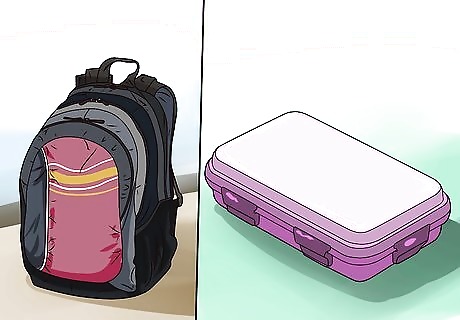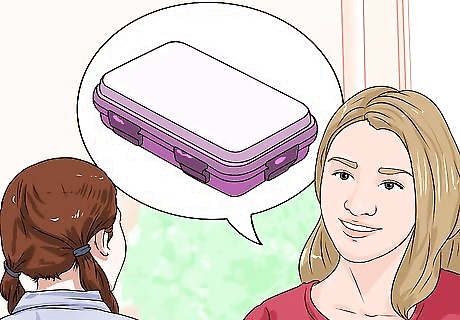
views
X
Research source
teachers.teachingsexualhealth.ca/downloads/Puberty-Kit-Description.pdf
Building a Home Kit

Get a large box. The idea of the home kit is that it will contain a wide variety of items relevant to your daughter’s puberty experience. Because of that, the kit is going to be substantially larger than the on-the-go kit, which focuses mostly on her period. Consider anything from a shoebox size to a large packing book box, but you should alter the box to adapt it to its new use: Make it look attractive and inviting by decorating it. Decorate the inside with tissue paper or other materials. Do not write “Puberty Kit” on the box, as this might cause embarrassment with friends, siblings, or family members.

Consider what to put into the kit. The kit should prepare your daughter for a much wider range of puberty-related experiences than the on-the-go kit. You should include a variety of toiletries, personal hygiene items, and informational material. If you have space, also include beauty supply items or other things that might make your daughter feel less awkward or embarrassed about puberty. Try to make her feel excited about this life change.

Stock the kit. Go out and gather all the items you think your daughter might need. It is best to not buy too much at one time, as your daughter might wind up not liking certain brands or types of products. Consider a variety of products, such as different deodorants, razors, or types of pads or tampons. Include the following and more: Bras (try training and sports bras first). Antiperspirant deodorant. Scented body spray. Gentle face cleanser and an acne spot treatment that contains benzoyl peroxide. Razors specifically made for girls or women (you can also try electric razors). Shave gel. Pads and pantyliners. Tampons — start with "light" or "slender" and "regular" sizes. Hand sanitizer. A calendar to track her monthly cycle (there are now period calendars on mobile devices ). An informative book about menstruation. An "all about a girl's body" book. An extra pair of underwear and pants

Introduce the kit. You then need to give your daughter the kit. It is best that you do this in the context of a talk about puberty. Also, try not to act embarrassed. Your daughter should feel comfortable with the kit, as it aids her through a normal part of life. Make sure to explain the need for all of the items in the kit. Remember, this is an opportunity for you and your daughter to bond, and for you to share your life experience with her and to prepare her for the exciting time before her!

Keep the lines of communication open. Communication is one of the most important intangible aspects of the kit. Make sure you continually follow up with your daughter over the next weeks and months (and after, of course). Let your daughter know that she can take some time to think about the kit and get back to you if she has further questions about puberty or how to use something in the kit.
Building a Portable Kit

Get a bag, small container, or crayon box. The portable kit is geared toward preparing your daughter, in terms of material items, for her period. The idea of the kit is that it is portable and your daughter can put it in her backpack or take it with her to a friend’s house overnight. You can sew a bag yourself, use a pencil case, buy a small makeup bag from a pharmacy, or use a crayon box. You could also use a zippered compartment of a school bag or purse.

Consider what to put into the kit. These supplies should be things that your daughter might immediately need in the event that her period comes by surprise or at an inopportune time. Not every woman has the same flow or the same needs, so it is best to over-prepare until you know the character of your daughter’s menstruation. But remember, the kit needs to be small enough to put into a backpack or overnight bag. Consider the following: If she’s had her first period. What products both of you like best. How heavy her flow is (if she’s had her first period).

Stock the kit. There are a number of things you should put in the kit. These items will prepare her for most scenarios and most emergencies. Hopefully, it will give both you and your daughter the peace of mind that she'll be prepared when the time comes. 2 Pantiliners 2 Pads (add more, if you don't use tampons). 2 Tampons in different sizes (add more, if you don't use pads). Midol or Ibuprofen for cramps. Hand sanitizer. Explain that she should wash her hands and use soap or use sanitizer before and after taking off and applying a pad or tampon. A small pack of tissues. If there is a shortage of toilet paper or she needs to be more discrete. An extra pair of panties and pants. Just in case. A mini garbage bag or ziplock bag. If she doesn’t have access to garbage, she can put her used supplies in a plastic bag and dispose of them later. A small pack of wipes. Wipes are much more durable than toilet paper, but be sure to tell your daughter not to flush them down the toilet.

Introduce the kit. Now you’ve got to sit down with her and have a discussion about the purpose and need of the kit. Explain that the kit is for emergencies and for on the go. It is better to be prepared than to be caught unprepared. Avoid embarrassing her, and reassure her that puberty and her period is a normal part of life. This discussion is best had after you’ve initiated a long-term discussion about growing up, puberty, and even sex.



















Comments
0 comment